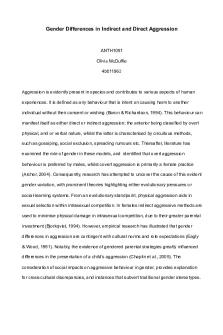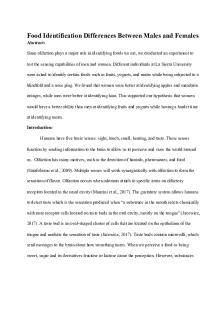Gender Differences Essay PDF

| Title | Gender Differences Essay |
|---|---|
| Author | Olivia Paige |
| Course | Human Evolution and Diversity |
| Institution | Macquarie University |
| Pages | 6 |
| File Size | 100.9 KB |
| File Type | |
| Total Downloads | 43 |
| Total Views | 146 |
Summary
Download Gender Differences Essay PDF
Description
Gender Differences in Indirect and Direct Aggression
Aggression is evidently present in species and contributes to various aspects of human experiences. It is defined as any behaviour that is intent on causing harm to another individual without their consent or wishing (Baron & Richardson, 1994). This behaviour can manifest itself as either direct or indirect aggression; the anterior being classified by overt physical, and or verbal nature, whilst the latter is characterised by circuitous methods, such as gossiping, social exclusion, spreading rumours etc. Thereafter, literature has examined the role of gender in these models, and identified that overt aggression behaviour is preferred by males, whilst covert aggression is primarily a female practice (Archer, 2004). Consequently, research has attempted to uncover the cause of this evident gender variation, with prominent theories highlighting either evolutionary pressures or social-learning systems. From an evolutionary standpoint, physical aggression aids in sexual selection within intrasexual competition. In females indirect aggressive methods are used to minimise physical damage in intrasexual competition, due to their greater parental investment (Bjorkqvist, 1994). However, empirical research has illustrated that gender differences in aggression are contingent with cultural norms and role expectations (Eagly & Wood, 1991). Notably, the existence of gendered parental strategies greatly influenced differences in the presentation of a child’s aggression (Chaplin et al., 2005). The consideration of social impacts on aggressive behaviour in gender, provides explanation for cross-cultural discrepancies, and instances that subvert traditional gender stereotypes.
1.
The benefits of overt aggression in males as an evolutionary adaptation through sexual selection competition.
- Males have fewer access to reproduce due to women’s limited reproduction abilities, and women’s high mating standards resulting in competition amongst males (Geary, 1998)
- Within social situations, males use physical aggression to increase social dominance, a trait that women value and are subconsciously attracted to (Maner et al., 2008)
- Testosterone, a male sex hormone, is shown to be produced in competitive situations, particularly physical in nature, and shows promotion of aggression (Delville et al., 1996)
- Booth & Dabbs Jr. (1993) highlight this biological link to sexual competition, finding testosterone levels lowered significantly after a man gets married, but rises again after divorce
2. Women partake in indirect aggression due to high parental investment
- Offspring survival is largely reliant on mothers, suggesting thats why females choose to not partake in physical aggressive tactics (Campbell, 1999)
- Younger women showed higher rates of indirect aggression through gossiping, than older women, suggesting interasexual competition for mates (Massar et al., 2012)
- The largest predictor of being victim to indirect aggression was attractiveness level. This aggression was used to intimidate their competitors and diminish a females mating value (Arnocky et al., 2011)
- Vaillancourt & Sharma (2011) experiment found females only engaged in indirect aggression, when interrupted by a women dressed provocatively.
3. Females prevalence to be indirect is greatly impacted through socialisation, and parental teaching strategies
- The high level of victimisation of underweight girls in indirect aggression conveys a societal influence, with established links between a mother’s body attitudes, and their daughters’ focus on body weight (Levine et al., 1994)
- A study of aggression trajectory in adolescents showed an increase of indirect aggressive approaches in girls between the ages of 4-6, replacing previously shown overt aggressive behaviour (Vaillancourt et al., 2007)
- The increase in indirect aggression in girls, is positively correlated with hostile/ ineffective parenting methods (Vaillancourt et al., 2007)
- Fathers’ gender-differentiated treatment of boys and girls greatly predicted aggressive behaviour a year later. When fathers’ attitudes were counter- stereotypical, the use of physical control strategies on girls predicted aggressive behaviour (Endendijk et al., 2016)
4. Socialisation of masculine gender roles encourages physical aggression in males
- Parents have shown to frequently use physical control, only with boys and not girls (Kochanska et al., 2009)
- Whiting & Edwards (1973) findings showed that in societies that featured men in caregiving roles, boys were more nurturing and gentle, and non aggressive
- Additionally, between 1931-1993 the gender differences in physical aggression decreased, as societal opinions changed. (Twenge, 2001)
- Male’s adherence and beliefs of traditional gender-role stereotypes, determines the likelihood to engage in sexual violence against women (Archer, 2004).
Evidently, aggression is a central evolutionary adaption through its function in securing survival and prosperous offspring. This same motivation for aggressive behaviour is present in both genders, although presentation differs. For males, overt aggression is suggested as a result of limited reproduction opportunities, causing Intrasexual competition (Geary, 1998). This perspective is strengthened by the behaviour of testosterone, promoting aggression within competitive contexts and diminishing thereafter (Delville et al.,1996). Within females, the use of indirect aggression is presumed to diminish other women mating values, through ostracisation (Arnocky et al., 2011). Due to the high paternal investment and lesser physical strength, non-physical attacks alleviate possible damage to reproductive capabilities (Campbell, 1999). However, this theory is limited in it’s abilities to explain rationales in instances of counterstereotypical gender roles, and the associations of gendered treatment to aggressive performance. Socialisation theory provides explanation for the preference for direct or indirect aggressive tactics. The effects of parental treatment is consistent with this model, as parent’s gendered beliefs impacted the way in which children presented aggression (Endendijk et al., 2016). Furthermore, societies that reflect egalitarian views showed a lesser disparity of physical aggression between genders (Whiting & Edwards, 1973), providing further evidence to social learning effects. This is reflected in the trajectory of society’s feminism movement and the decrease of gender differences in physical aggression (Twenge, 2001). Conclusively, evolutionary pressures in humans reproduction perhaps are still present in subconscious means. Nonetheless, societal perceptions influence desirable traits, resulting in varying parental treatment based on gender. In this sense, aggression is an innate behaviour due to evolutionary pressures, though the presentation is a consequence of gendered stereotypes.
References Archer, J. (2004). Sex Differences in Aggression in Real-World Settings: A Meta-Analytic Review. Review of General Psychology, 8(4), 291–322. doi: 10.1037/1089-2680.8.4.291 Arnocky, S., Sunderani, S., Miller, J. L., & Vaillancourt, T. (2011). Jealousy mediates the relationship between attractiveness comparison and females indirect aggression. Personal Relationships, 19(2), 290–303. doi: 10.1111/j.1475-6811.2011.01362.x Baron, R. A., & Richardson, D. S. (1994). Human aggression. New York: Plenum Press Bjorkqvist, K. (1994). Sex differences in physical, verbal, and indirect aggression: A review of recent research. Sex Roles, 30(3-4), 177–188. doi: 10.1007/bf01420988 Booth, A., & Dabbs, J. M. (1993). Testosterone and Mens Marriages. Social Forces, 72(2), 463. doi: 10.2307/2579857 Campbell, A. (1999). Staying alive: Evolution, culture, and womens intrasexual aggression. Behavioral and Brain Sciences, 22(2), 203–214. doi: 10.1017/s0140525x99001818 Chaplin, T. M., Cole, P. M., & Zahn-Waxler, C. (2005). Parental Socialization of Emotion Expression: Gender Differences and Relations to Child Adjustment. Emotion, 5(1), 80–88. doi: 10.1037/1528-3542.5.1.80 Delville, Y., Mansour, K. M., & Ferris, C. F. (1996). Testosterone facilitates aggression by modulating vasopressin receptors in the hypothalamus. Physiology & Behavior, 60(1), 25– 29. doi: 10.1016/0031-9384(95)02246-5 Eagly, A. H., & Wood, W. (1991). Explaining Sex Differences in Social Behavior: A MetaAnalytic Perspective. Personality and Social Psychology Bulletin, 17(3), 306–315. doi: 10.1177/0146167291173011 Endendijk, J. J., Groeneveld, M. G., Pol, L. D. V. D., Berkel, S. R. V., Hallers-Haalboom, E. T., Bakermans-Kranenburg, M. J., & Mesman, J. (2016). Gender Differences in Child Aggression: Relations With Gender-Differentiated Parenting and Parents’ Gender-Role Stereotypes. Child Development, 88(1), 299–316. doi: 10.1111/cdev.12589 Geary, D. C. (1998). Male, female: The evolution of human sex differences. doi: 10.1037/10370-000 Kochanska, G., Barry, R. A., Stellern, S. A., & O’Bleness, J. J. (2009). Early Attachment Organization Moderates the Parent-Child Mutually Coercive Pathway to Children’s Antisocial Conduct. Child Development, 80(4), 1288–1300. doi: 10.1111/j. 1467-8624.2009.01332.x Levine, M. P., Smolak, L., & Hayden, H. (1994). The Relation of Sociocultural Factors to Eating Attitudes and Behaviors among Middle School Girls. The Journal of Early Adolescence, 14(4), 471–490. doi: 10.1177/0272431694014004004
Maner, J. K., Dewall, C. N., & Gailliot, M. T. (2008). Selective Attention to Signs of Success: Social Dominance and Early Stage Interpersonal Perception. Personality and Social Psychology Bulletin, 34(4), 488–501. doi: 10.1177/0146167207311910 Massar, K., Buunk, A. P., & Rempt, S. (2012). Age differences in women’s tendency to gossip are mediated by their mate value. Personality and Individual Differences, 52(1), 106–109. doi: 10.1016/j.paid.2011.09.013 Twenge, J. M. (2001). Changes in womens assertiveness in response to status and roles: A cross-temporal meta-analysis, 1931–1993. Journal of Personality and Social Psychology, 81(1), 133–145. doi: 10.1037/0022-3514.81.1.133 Vaillancourt, T., Miller, J. L., Fagbemi, J., Côté, S., & Tremblay, R. E. (2007). Trajectories and predictors of indirect aggression: results from a nationally representative longitudinal study of Canadian children aged 2–10. Aggressive Behavior, 33(4), 314–326. doi: 10.1002/ ab.20202 Vaillancourt, T., & Sharma, A. (2011). Intolerance of sexy peers: intrasexual competition among women. Aggressive Behavior, 37(6), 569–577. doi: 10.1002/ab.20413 Whiting, B., & Edwards, C. P. (1973). A Cross-Cultural Analysis of Sex Differences in the Behavior of Children Aged Three Through 11. The Journal of Social Psychology, 91(2), 171–188. doi: 10.1080/00224545.1973.9923040...
Similar Free PDFs

Gender Differences Essay
- 6 Pages

Gender differences in crime
- 6 Pages

Gender differences in senses
- 11 Pages

Gender and Sexuality Essay
- 11 Pages

Gender Inequality Essay
- 6 Pages

Gender roles essay
- 6 Pages

Gender Inequality Essay
- 4 Pages

Gender Studies Essay 2
- 6 Pages

Gender identity essay
- 5 Pages

Gender Photo Essay
- 5 Pages

Gender crime violence essay
- 8 Pages

Gender Equality IN Islam Essay
- 6 Pages

Gender essay Being a Man
- 4 Pages
Popular Institutions
- Tinajero National High School - Annex
- Politeknik Caltex Riau
- Yokohama City University
- SGT University
- University of Al-Qadisiyah
- Divine Word College of Vigan
- Techniek College Rotterdam
- Universidade de Santiago
- Universiti Teknologi MARA Cawangan Johor Kampus Pasir Gudang
- Poltekkes Kemenkes Yogyakarta
- Baguio City National High School
- Colegio san marcos
- preparatoria uno
- Centro de Bachillerato Tecnológico Industrial y de Servicios No. 107
- Dalian Maritime University
- Quang Trung Secondary School
- Colegio Tecnológico en Informática
- Corporación Regional de Educación Superior
- Grupo CEDVA
- Dar Al Uloom University
- Centro de Estudios Preuniversitarios de la Universidad Nacional de Ingeniería
- 上智大学
- Aakash International School, Nuna Majara
- San Felipe Neri Catholic School
- Kang Chiao International School - New Taipei City
- Misamis Occidental National High School
- Institución Educativa Escuela Normal Juan Ladrilleros
- Kolehiyo ng Pantukan
- Batanes State College
- Instituto Continental
- Sekolah Menengah Kejuruan Kesehatan Kaltara (Tarakan)
- Colegio de La Inmaculada Concepcion - Cebu


